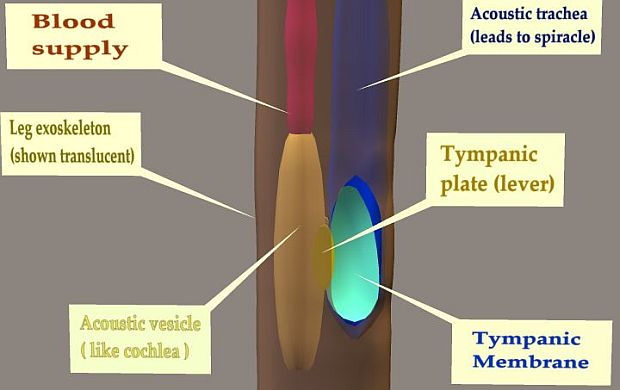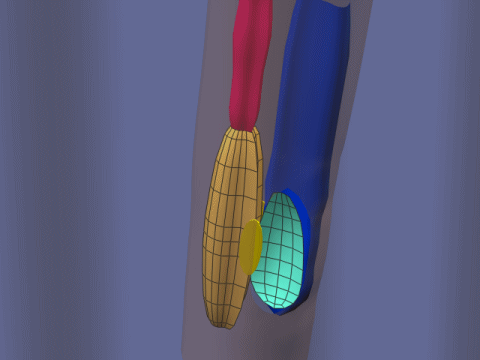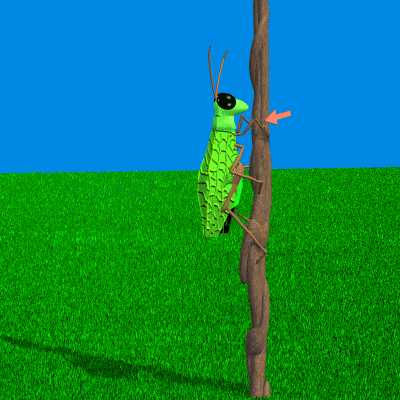Monday, November 19, 2012
See what happens when you LOOK?
Wonderful example of what can happen when you decide to look closely at something, instead of fucking around with numbers and potentialities and apocalyptic religious delusions. In other words, when you do ACTUAL FUCKING SCIENCE.
Katydids are thoroughly familiar insects. We've all heard them, seen them, probably handled them or batted them away when they jumped on us. We knew that they made sounds with their legs, and that they somehow heard with their legs.
Now someone finally decided to look closely, with amazing results.
A team at Lincoln Univ in Britain used electron microscopes to examine the ears, which are inside the front pair of legs.
I've done a 3d pic and animation based on their descriptions.
Each of the front legs has a pair of tiny openings. Behind each opening is a tympanic membrane, much like ours.
 I've shown one side of the leg here. Each Tympanic Membrane (eardrum) has a 'plate' or lever on one edge, serving as a leverage multiplier like our Ossicles. The plate transfers the wave motions to a fluid-filled Acoustic Vesicle, which plays the same role as our Cochlea. The Vesicle picks up the waves from both drums in this leg. It contains hair cells that wave back and forth, sending neural signals to the katydid's brain. Fluid inside the Vesicle is a dense version of the insect's blood, again just like the fluid in our Cochlea; and the hair cells are tuned for different frequencies, just like ours.
Eardrums need to avoid being moved by changes in atmospheric pressure, which can be much larger than sound pressure. Mammalian ears balance the pressure on both sides of the drum via the Eustachian tube that opens into the nasal passages, insuring that the middle ear chamber stays at the same pressure as the air outside the skull. The katydid solves the same problem with an Acoustic Trachea, a tube running up the leg, into the body, and thence into one of the insect's 'lungs'.
When sound impinges, each eardrum transfers its energy to a 'pinch' on one side of the Vesicle.
I've shown one side of the leg here. Each Tympanic Membrane (eardrum) has a 'plate' or lever on one edge, serving as a leverage multiplier like our Ossicles. The plate transfers the wave motions to a fluid-filled Acoustic Vesicle, which plays the same role as our Cochlea. The Vesicle picks up the waves from both drums in this leg. It contains hair cells that wave back and forth, sending neural signals to the katydid's brain. Fluid inside the Vesicle is a dense version of the insect's blood, again just like the fluid in our Cochlea; and the hair cells are tuned for different frequencies, just like ours.
Eardrums need to avoid being moved by changes in atmospheric pressure, which can be much larger than sound pressure. Mammalian ears balance the pressure on both sides of the drum via the Eustachian tube that opens into the nasal passages, insuring that the middle ear chamber stays at the same pressure as the air outside the skull. The katydid solves the same problem with an Acoustic Trachea, a tube running up the leg, into the body, and thence into one of the insect's 'lungs'.
When sound impinges, each eardrum transfers its energy to a 'pinch' on one side of the Vesicle.
 Aside from the pairing, there's only one major design difference between mammal and katydid. The katydid's paired eardrums push on the side of the Vesicle, while our eardrum pushes on the end of our cochlea:
The pair of eardrums on each leg makes me wonder.... does the katydid move its legs to do a complex form of localizing? With two pairs of ears that can be moved separately, you could triangulate in ways that we can't imagine! Or does it pick up polarized sound? Under normal conditions the longitudinal waves of airborne sound can't be polarized, but mechanically carried high-freq sound inside a plant stalk might be different. Paired ears on a leg, with the eardrums at a 90 degree angle, would be uniquely suited for picking up the separate polarizations. (Think of a stereo LP record to get the idea.)
Aside from the pairing, there's only one major design difference between mammal and katydid. The katydid's paired eardrums push on the side of the Vesicle, while our eardrum pushes on the end of our cochlea:
The pair of eardrums on each leg makes me wonder.... does the katydid move its legs to do a complex form of localizing? With two pairs of ears that can be moved separately, you could triangulate in ways that we can't imagine! Or does it pick up polarized sound? Under normal conditions the longitudinal waves of airborne sound can't be polarized, but mechanically carried high-freq sound inside a plant stalk might be different. Paired ears on a leg, with the eardrums at a 90 degree angle, would be uniquely suited for picking up the separate polarizations. (Think of a stereo LP record to get the idea.)
 Some amazing examples of what Katy might hear on the literal grapevine!
In any case this gives evidence for the notion that the Grand Blueprint is more a 'specification of purpose' than a 'specification of materials'. The permanent genes determine what an organism intends to do in life, not merely how to build a subsystem that serves the purpose.
= = = = =
Much later update (12/2021): A new article details the internal tuning of the katydid's cochlea, and again the parallels are nearly perfect. The tympanum sends waves along a length of sensory tissue. The tissue is built to create a tonotopic response. These experimenters didn't try to vary the polarization of the input wave, which seems like the most important advantage of the katydid structure.
Some amazing examples of what Katy might hear on the literal grapevine!
In any case this gives evidence for the notion that the Grand Blueprint is more a 'specification of purpose' than a 'specification of materials'. The permanent genes determine what an organism intends to do in life, not merely how to build a subsystem that serves the purpose.
= = = = =
Much later update (12/2021): A new article details the internal tuning of the katydid's cochlea, and again the parallels are nearly perfect. The tympanum sends waves along a length of sensory tissue. The tissue is built to create a tonotopic response. These experimenters didn't try to vary the polarization of the input wave, which seems like the most important advantage of the katydid structure.
 I've shown one side of the leg here. Each Tympanic Membrane (eardrum) has a 'plate' or lever on one edge, serving as a leverage multiplier like our Ossicles. The plate transfers the wave motions to a fluid-filled Acoustic Vesicle, which plays the same role as our Cochlea. The Vesicle picks up the waves from both drums in this leg. It contains hair cells that wave back and forth, sending neural signals to the katydid's brain. Fluid inside the Vesicle is a dense version of the insect's blood, again just like the fluid in our Cochlea; and the hair cells are tuned for different frequencies, just like ours.
Eardrums need to avoid being moved by changes in atmospheric pressure, which can be much larger than sound pressure. Mammalian ears balance the pressure on both sides of the drum via the Eustachian tube that opens into the nasal passages, insuring that the middle ear chamber stays at the same pressure as the air outside the skull. The katydid solves the same problem with an Acoustic Trachea, a tube running up the leg, into the body, and thence into one of the insect's 'lungs'.
When sound impinges, each eardrum transfers its energy to a 'pinch' on one side of the Vesicle.
I've shown one side of the leg here. Each Tympanic Membrane (eardrum) has a 'plate' or lever on one edge, serving as a leverage multiplier like our Ossicles. The plate transfers the wave motions to a fluid-filled Acoustic Vesicle, which plays the same role as our Cochlea. The Vesicle picks up the waves from both drums in this leg. It contains hair cells that wave back and forth, sending neural signals to the katydid's brain. Fluid inside the Vesicle is a dense version of the insect's blood, again just like the fluid in our Cochlea; and the hair cells are tuned for different frequencies, just like ours.
Eardrums need to avoid being moved by changes in atmospheric pressure, which can be much larger than sound pressure. Mammalian ears balance the pressure on both sides of the drum via the Eustachian tube that opens into the nasal passages, insuring that the middle ear chamber stays at the same pressure as the air outside the skull. The katydid solves the same problem with an Acoustic Trachea, a tube running up the leg, into the body, and thence into one of the insect's 'lungs'.
When sound impinges, each eardrum transfers its energy to a 'pinch' on one side of the Vesicle.
 Aside from the pairing, there's only one major design difference between mammal and katydid. The katydid's paired eardrums push on the side of the Vesicle, while our eardrum pushes on the end of our cochlea:
The pair of eardrums on each leg makes me wonder.... does the katydid move its legs to do a complex form of localizing? With two pairs of ears that can be moved separately, you could triangulate in ways that we can't imagine! Or does it pick up polarized sound? Under normal conditions the longitudinal waves of airborne sound can't be polarized, but mechanically carried high-freq sound inside a plant stalk might be different. Paired ears on a leg, with the eardrums at a 90 degree angle, would be uniquely suited for picking up the separate polarizations. (Think of a stereo LP record to get the idea.)
Aside from the pairing, there's only one major design difference between mammal and katydid. The katydid's paired eardrums push on the side of the Vesicle, while our eardrum pushes on the end of our cochlea:
The pair of eardrums on each leg makes me wonder.... does the katydid move its legs to do a complex form of localizing? With two pairs of ears that can be moved separately, you could triangulate in ways that we can't imagine! Or does it pick up polarized sound? Under normal conditions the longitudinal waves of airborne sound can't be polarized, but mechanically carried high-freq sound inside a plant stalk might be different. Paired ears on a leg, with the eardrums at a 90 degree angle, would be uniquely suited for picking up the separate polarizations. (Think of a stereo LP record to get the idea.)
 Some amazing examples of what Katy might hear on the literal grapevine!
In any case this gives evidence for the notion that the Grand Blueprint is more a 'specification of purpose' than a 'specification of materials'. The permanent genes determine what an organism intends to do in life, not merely how to build a subsystem that serves the purpose.
= = = = =
Much later update (12/2021): A new article details the internal tuning of the katydid's cochlea, and again the parallels are nearly perfect. The tympanum sends waves along a length of sensory tissue. The tissue is built to create a tonotopic response. These experimenters didn't try to vary the polarization of the input wave, which seems like the most important advantage of the katydid structure.
Some amazing examples of what Katy might hear on the literal grapevine!
In any case this gives evidence for the notion that the Grand Blueprint is more a 'specification of purpose' than a 'specification of materials'. The permanent genes determine what an organism intends to do in life, not merely how to build a subsystem that serves the purpose.
= = = = =
Much later update (12/2021): A new article details the internal tuning of the katydid's cochlea, and again the parallels are nearly perfect. The tympanum sends waves along a length of sensory tissue. The tissue is built to create a tonotopic response. These experimenters didn't try to vary the polarization of the input wave, which seems like the most important advantage of the katydid structure.
Labels: Grand Blueprint
